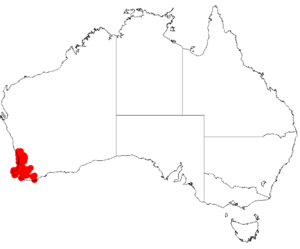Acacia huegelii facts for kids
Quick facts for kids Acacia huegelii |
|
|---|---|
| Scientific classification | |
| Genus: |
Acacia
|
| Species: |
huegelii
|
 |
|
| Occurrence data from AVH | |
Acacia huegelii is a type of shrub that belongs to the Acacia plant family. It is also known as a wattle. This plant is native to Western Australia, meaning it naturally grows there.
What Does Acacia huegelii Look Like?
This bushy plant often has many stems and some thorns. It usually grows to be about 0.2 to 1 meter (or 0.6 to 3.3 feet) tall. Its small branches can be smooth or a little bit hairy.
It has small, upright leaf-like parts called stipules, which are about 2 to 4 millimeters long. The plant's green, pointed leaves are actually flattened leaf stalks called phyllodes. These phyllodes are widest in the middle and are usually 7 to 16 millimeters long and 2 to 7 millimeters wide.
Acacia huegelii blooms with creamy yellow flowers from October to February. Its simple flower clusters grow one from each leaf joint. Each round flower head has 20 to 35 cream or white flowers. After the flowers, flat, curved, reddish-brown seed pods appear. These pods can be up to 40 millimeters long and 3.5 to 5 millimeters wide. Inside, they hold oblong, spotted seeds.
How Was Acacia huegelii Named?
The plant was first officially described in 1837 by a botanist named George Bentham. He included it in a larger work about plants found in Western Australia. Later, in 2003, another botanist, Leslie Pedley, reclassified it. However, it was moved back to the Acacia group in 2006.
The name huegelii honors Carl Alexander Anselm, Baron von Hugel. He was an Austrian naturalist who visited Western Australia in 1833. He collected the first sample of this plant near the Swan River.
Acacia huegelii is closely related to another wattle called Acacia forrestiana. It also has leaves similar to Acacia imparilis.
Where Does Acacia huegelii Grow?
This plant grows along the south coast of Western Australia. You can find it in the Peel and South West regions. It likes to grow on low ridges, flat areas, and sand dunes. It prefers sandy soils or gravelly soils that contain laterite.
Acacia huegelii is often found in woodlands or open forests where Banksia and Eucalyptus trees grow. In the southwestern areas, it can be seen in sandy dips between dunes, growing with plants like Agonis flexuosa and different types of Kunzea.

